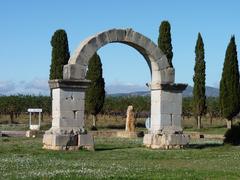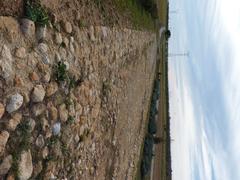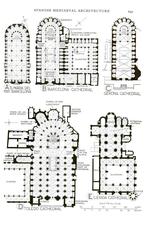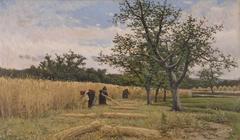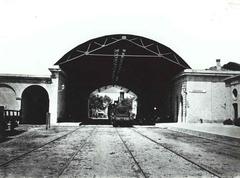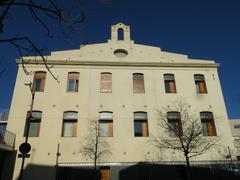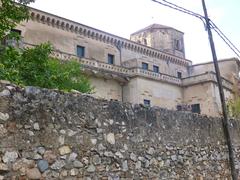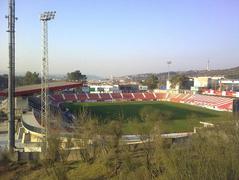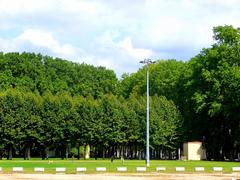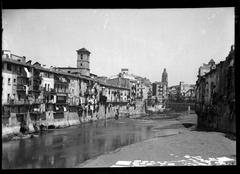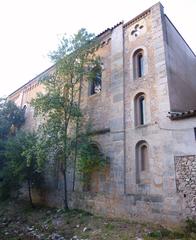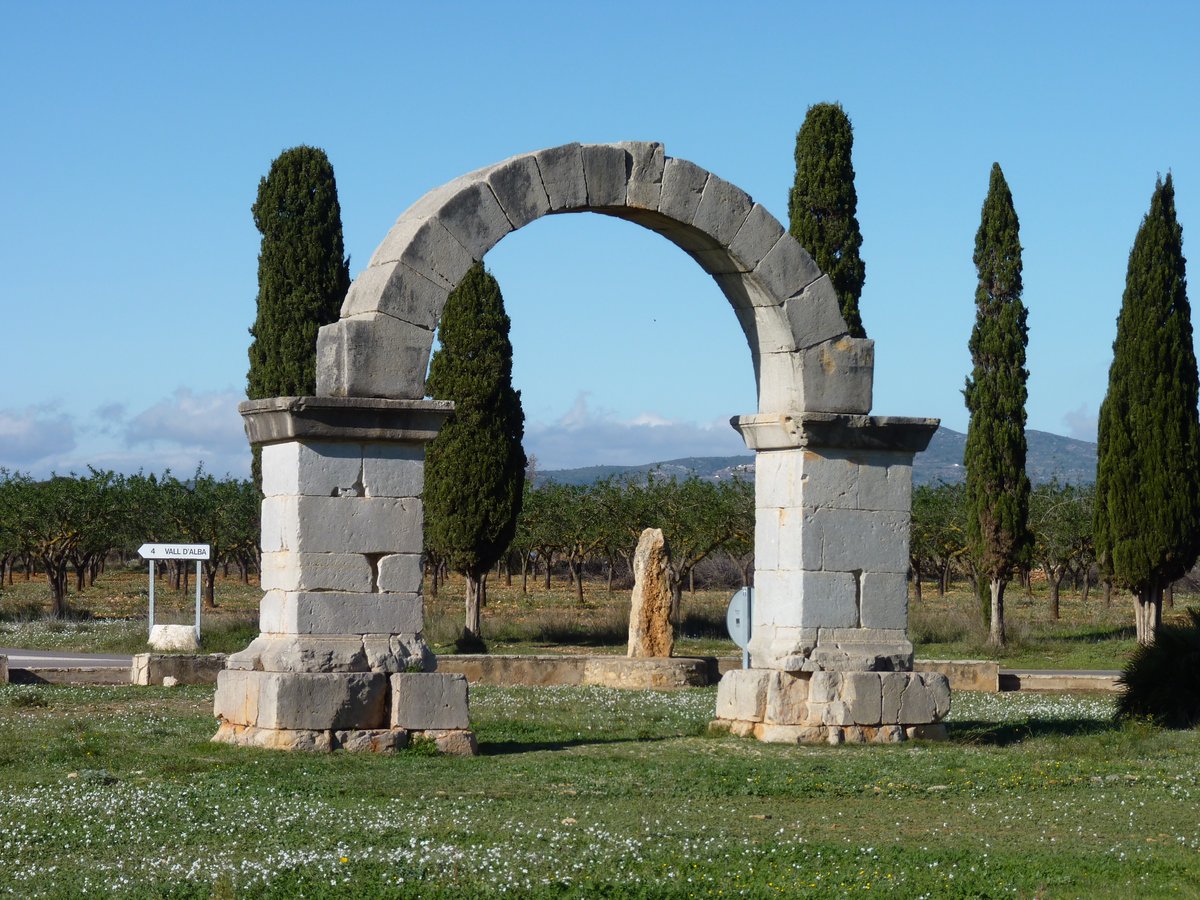
Via Augusta Girona: Comprehensive Visiting Hours, Tickets, and Historical Sites Guide
Date: 14/06/2025
Introduction: The Legacy of Via Augusta in Girona
Girona, a city rich with layers of history in Catalonia, Spain, owes much of its urban development and cultural significance to the Via Augusta—the most extensive Roman road in ancient Hispania. Spanning approximately 1,500 kilometers from the Pyrenees to Cádiz, the Via Augusta was crucial for the Roman Empire’s military, trade, and cultural exchange. Its path through Girona (ancient Gerunda) not only shaped the city’s infrastructure but also marked it as a vital hub in the Roman network (Wikipedia; All-Andorra).
Today, visitors can immerse themselves in Girona’s Roman heritage by exploring well-preserved milestones, the formidable Força Vella fortress, and the Roman city walls. Modern streets like Carrer de la Força echo the ancient route, providing a tangible connection to over two millennia of history. Girona’s dynamic cultural landscape also reflects Visigothic, Moorish, and medieval influences—visible in its Jewish Quarter, Gothic cathedral, and Arab Baths (Njoy Costa Brava; excurzilla.com).
This guide delivers detailed information on visiting hours, ticketing, guided tours, accessibility, and travel tips, ensuring a rewarding exploration of Girona’s Roman and multicultural heritage (spainguides.com; travelphotodiscovery.com).
Contents
- Introduction & Historical Overview
- Roman Origins and Strategic Purpose
- Construction and Engineering
- Urban and Economic Impact
- Defensive and Strategic Role
- Evolution Through the Ages
- Archaeological and Cultural Legacy
- Detailed Visitor Information
- Visiting Hours and Accessibility
- Tickets and Guided Tours
- Travel Tips
- Accessibility Considerations
- Noteworthy Nearby Attractions
- Visuals and Media Suggestions
- FAQs
- Conclusion and Recommendations
- Call to Action
Roman Origins and Strategic Role
The Via Augusta, constructed and expanded by order of Emperor Augustus between 8 BCE and 2 BCE, was originally built atop the earlier Via Heraclea. Girona’s location as Gerunda made it a focal point for Roman military campaigns and a crossroads for commerce and cultural interaction (Wikipedia; All-Andorra). Roman engineers set milestones and constructed paved roads, facilitating the movement of armies and goods—transforming Girona into an economic and strategic powerhouse (Pedres de Girona).
Construction and Engineering Features
Via Augusta’s construction was a marvel of Roman engineering, with broad stone slabs for two-way chariot traffic, drainage systems, and regularly placed milestones (miliaria) that marked distances and commemorated imperial achievements. In Girona, milestones and road remnants, some housed in local museums, attest to its enduring legacy (Wikipedia; Pedres de Girona).
Urban and Economic Impact on Girona
The arrival of the Via Augusta transformed Girona into a thriving Roman city. The road linked Girona to the port of Empúries, fueling commerce and urban growth. The modern Carrer de la Força traces the ancient route, integrating Roman heritage into the city’s daily life (Njoy Costa Brava).
Defensive and Strategic Role
Girona’s city walls—la Força Vella—were constructed to protect its strategic position along the Via Augusta. These fortifications, some of which still stand, offer panoramic city views and provide insight into Girona’s military past (Njoy Costa Brava; Visita Costa Brava).
Evolution Through the Ages
Via Augusta’s importance persisted through Visigothic, Moorish, and medieval eras, maintaining Girona as a key transportation and cultural corridor. Today’s highways, such as the N-340 and A-7, largely follow its original path (All-Andorra; Wikipedia).
Archaeological and Cultural Legacy
Visitors can explore Roman milestones, city walls, and the alignment of Carrer de la Força, revealing Girona’s cosmopolitan history. Museums, such as the Archaeological Museum in Sant Pere de Galligants, display artifacts from Roman, Jewish, and medieval periods (Njoy Costa Brava; Visita Costa Brava).
Detailed Visitor Information
Visiting Hours and Accessibility
- City Walls (Passeig de la Muralla): Open daily, generally 8:00 AM–8:00 PM (seasonal hours may vary). Free entry.
- Força Vella Fortress: Open from 10:00 AM–6:00 PM; no entrance fee.
- Archaeological Museum (Sant Pere de Galligants): Tuesday–Sunday, 10:00 AM–7:00 PM. Tickets ~€5; free on first Sunday monthly.
- Cathedral of Girona: Daily, 10:00 AM–6:30 PM. Tickets ~€7.
- Museum of Jewish History: Tuesday–Sunday, 10:00 AM–7:00 PM. Tickets ~€6.
Many major sites are pedestrian-friendly, but expect uneven terrain and stairs, particularly along the city walls and in the Jewish Quarter. Some museums offer ramps and elevators (spainguides.com; excurzilla.com).
Tickets and Guided Tours
- City Walls & Força Vella: Free access.
- Museums and Baths: Entrance fees typically €4–€7; tickets available online or at site.
- Guided Tours: Walking tours focusing on Roman and medieval Girona cost €10–€25 per person. Booking in advance is recommended, especially during peak season (Along Dusty Roads).
Travel Tips
- Best Times to Visit: Spring (April–June) and autumn (September–October) offer mild weather and fewer crowds.
- Getting There: Girona is 30–40 minutes from Barcelona by high-speed train; station is 15 minutes’ walk from the Old Town.
- Footwear: Comfortable shoes are essential due to cobbled streets and steep walks.
- Facilities: Restrooms, cafés, and shops are available throughout the Old Town (Along Dusty Roads; Happy to Wander).
Accessibility Considerations
While many main attractions are accessible, some areas, especially the walls and the Jewish Quarter, may not be suitable for wheelchairs. Check individual sites for accessibility details or contact the Girona tourism office before visiting.
Noteworthy Nearby Attractions
- Caldes de Malavella: Roman thermal baths and milestones, 20 minutes by train.
- Besalú: Medieval village with a Romanesque bridge, less than an hour by car.
- Ullastret: Ancient Iberian settlement, accessible for day trips (Europcar).
Visuals and Media Suggestions
- Images: Feature photos of Via Augusta Roman milestones, city walls, and the Jewish Quarter. Suggested alt tags: “Roman milestone in Girona,” “Passeig de la Muralla panoramic view,” “Jewish Quarter alley in Girona.”
- Interactive Maps: Use online resources to follow the ancient Via Augusta route through Girona.
- Virtual Tours: Available for the Archaeological Museum and Força Vella via official tourism sites.
Frequently Asked Questions (FAQ)
Q: What are the Via Augusta Girona visiting hours?
A: City walls are open daily, generally 8:00 AM–8:00 PM. Museums and the cathedral typically open 10:00 AM–6:00/7:00 PM; check individual sites for seasonal changes.
Q: Are tickets required to visit the Roman sites in Girona?
A: City walls and Força Vella are free. Museums and baths charge entrance fees, with tickets available online or at the entrance.
Q: Are guided tours available?
A: Yes, many companies offer guided walking tours focusing on Roman and medieval Girona. Advance booking is recommended.
Q: Is the Via Augusta route accessible for people with disabilities?
A: Some areas, especially the city walls and Jewish Quarter, have uneven terrain or stairs. Many museums are accessible, but check in advance for specific needs.
Q: What’s the best way to reach Girona?
A: High-speed trains from Barcelona are convenient. Parking is very limited in the Old Town; public transport and walking are recommended.
Q: When is the best time to visit?
A: Spring and autumn provide pleasant weather and fewer crowds. Festivals in June and July are lively but can be crowded (All Events in Girona).
Conclusion and Recommendations
Exploring the Via Augusta in Girona allows visitors to journey through layers of history, from Roman engineering and urban planning to medieval fortifications and vibrant multicultural neighborhoods. Walking the city walls, visiting the Archaeological Museum, and wandering the Jewish Quarter offer a comprehensive look at Girona’s evolution. Proximity to other ancient sites like Besalú and Caldes de Malavella further enriches any itinerary (spainguides.com; Njoy Costa Brava).
Call to Action
Ready to uncover Girona’s Roman roots? Download the Audiala app for interactive maps, guided audio tours, and real-time visitor updates. Explore our related articles on Girona’s cathedral, baths, and medieval sites, and follow us on social media for fresh travel inspiration.
References and Further Reading
- Wikipedia
- All-Andorra
- Pedres de Girona
- Njoy Costa Brava
- Visita Costa Brava
- Europcar
- explorespainguide.com
- excurzilla.com
- thetravelblogs.com
- spainguides.com
- travelphotodiscovery.com
- ordendelcaminodesantiago.es
- vickiviaja.com
- Destinations Detours and Dreams
- Along Dusty Roads
- Happy to Wander
- Time Out Girona
- All Events in Girona
